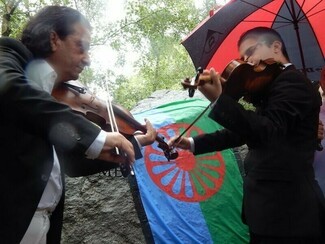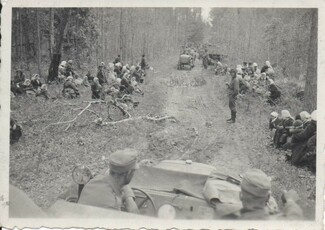Remembering the Genocide of the Roma: A History We Still Don’t Teach

Each year on 2nd August, Romani communities across Europe gather to mark the anniversary of a crime that too many still do not know took place. On the night of 2nd August in 1944, nearly 3,000 Sinti and Roma men, women and children were murdered in a single night at Auschwitz-Birkenau. It was not the beginning, nor the end, of their persecution – but it was one of the darkest chapters in a long, brutal story.
This story is still not told in most schools. In Britain, as in many other countries, the persecution and genocide of the Sinti and Roma during the Nazi era is not explicitly referenced in the national curriculum.
We must ask: what is remembrance without education? What is the point of memory if we do not pass it on?
Survivors’ testimonies are living proof of what happens when people are dehumanised, targeted, and erased from history – a truth I’ve come to know deeply in my work with the International Holocaust Remembrance Alliance (IHRA).
Take Maria Stancu-Costea, who was just six years old when her family was deported from their home in Romania to a remote, freezing camp by the River Bug, from which she tried to escape. Or Rita Prigmore, a German Sinti woman who underwent medical experiments together with her newborn twin sister. Rita survived. Her twin sister, Rolanda, died before she was one month old.
We have an obligation not only to preserve the legacy of these survivors, but to embrace it – by learning from it, teaching it, and acting on it.
Another survivor, Zoni Weisz, was just seven when his family was deported to Westerbork and then to Auschwitz-Birkenau. He escaped the transport with help from a Dutch police officer – but his parents and siblings were all murdered. He put it plainly: “I lost my entire family during the National Socialist era. This is something that must never happen again… but society has learned next to nothing. I want our young people to have a future. They should no longer suffer from marginalisation but have equal access to education and work”.
These stories matter. They teach us what the genocide of the Roma was – and what anti-Roma discrimination still is. That discrimination is not a thing of the past. It is present in the slurs hurled on the streets, the children excluded from school, and the prejudice built into policy.
Commemorating the genocide of the Roma is not just about honouring the dead – it is about protecting the living. That is why the IHRA continues to call on governments to adopt a working definition of antigypsyism and to make use of our Recommendations of Teaching and Learning about the Persecution and the Genocide of the Roma during the Nazi era. We must ensure that the history of Nazi atrocities, in all its complexity, is taught truthfully and inclusively.

Above: The start of the massacre of Romani people in the Thuringian Forest in Germany, by German soldiers. Date unknown. The Thuringian Forest is about 30km east of what was the centre of the Buchenwald concentration camp complex, near Weimar, in Germany. The building of Buchenwald started in 1937, and it was liberated by USA soldiers on April 11th, 1945. reproduced courtesy of the Robert Dawson Collection
Here in the UK, that means keeping the promise of a national memorial for the genocide of the Roma in Newcastle. It means giving young people the full history, not a selective one. And it means recognising that Roma voices are central to meaningful education about this history.
The sites of these crimes still stand. They are witnesses in stone – and their silence speaks volumes when we fail to tell the whole story.
This year, let us stop talking about the genocide of the Roma as if it were a footnote. It was – and remains – a central lesson in what happens when we fail to protect citizen’s rights and see each other as fully human.
By Michaela Küchler, Secretary General of the International Holocaust Remembrance Alliance
(Lead photograph: Romani musicians play at a gathering of remembrance for the Romany victims of the Holocaust on August 2nd, 2015. Hyde Park Holocaust Memorial Garden, London, UK (c) Mike Doherty/Travellers Times)